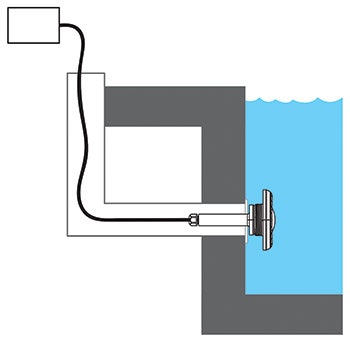
Walking in the door after a day at work, today's homeowner may lay his phone on a charger to juice up for the evening. There's no wire connection, but electrons are moving and a current is being generated inside the phone to build potential in the battery.
There are a number of devices that are charged in this way — through the air, without the copper wire that for over a century was the only way to transmit electrical power.
And now there are pool lights on the market that use the same technology to produce current and light a pool without any physical connection.
The science behind it has been around since Tesla (not the car maker) and Faraday and the 19th century. It's how hydroelectric dams produce electricity, but of course, dams do it on a much larger scale. If you create a moving magnetic field, which can be done by simply moving a magnet or using an alternate electric current, you can induce current in nearby coils of wire.
That's how all these devices work. A moving magnetic field creates current in a nearby smartphone, electric toothbrush or, in our case, pool light. The device must be physically close because the magnetic field becomes exponentially weaker with distance. So as your wireless pool light is moved within a certain proximity of the source of power, though nothing but empty space lies between, it comes to life.
The ideal proximity is just next to the power source. In the case of the pool light, the impervious, sealed-plastic exterior wall of the power source fits right next to the impervious, sealed-plastic wall of the pool light. Thus the problem of water — its conductivity, its corrosiveness — is eliminated, confined behind a wall of plastic.
Two companies have jumped into the lead in applying this technology to the pool industry: S.R. Smith and CCEI. S.R. Smith makes the Mod-Lite and CCEI makes the Plug In Pool Light. Some of the advantages they offer are obvious, and some less obvious.
Perhaps the most conspicuous is how these products eliminate that threat of electrocution. With no metal wire connection between the source of power and the pool light, the pool is made safer. Everyone in the pool industry reads about electrocution fatalities on a fairly regular basis, at a rate of about one per year. Injuries and shocking incidents are far more common. Induction lighting eliminates that risk.
Beyond actual injuries and fatalities, a wireless connection in a pool niche removes the threat of electrocution, allowing pool servicers to work freely in and around the light fixture without even switching off the power.
The second glaring advantage to a light that has no physical connection to the power source is the ease of removal and replacement. It simply screws on and off like the cap on a gallon of milk.
In situations where a light needs to be removed or replaced — for winterizing, vinyl-liner removal or because it's simply reached the end of its service life — the task takes seconds and a twist of the wrist instead of the time it takes to switch off the power, remove the (sometimes rusty) screws, pry the fixture out with a flathead, pull the light up on deck, etc.
And the job requires no skill and therefore no skilled labor. It can be done underwater if necessary without risk to the service person.
With such easy replacement, manufacturers of wireless lighting envision these products will help service pros save time on winterizing jobs. Brett Fritts, COO of S.R. Smith, notes that a number of steps are required in a typical winterizing stop, from blowing out the pipes to chemically treating the pool. Often the job includes removal of the pool light for the winter, "The aim of the Mod- Lite is to make that portion of the job take about 30 seconds instead of 30 minutes," he says, which can help the service pro complete more winterizing jobs per day or week.
These benefits have been immediately recognized by pool professionals in the field who have installed induction lights. Scott Rom, owner of Duck's Pool Service in Las Vegas, Nev., has installed a few of S.R. Smith's Mod-Lites as replacements for fiber-optic lights in pools.
 Induction light screws in below the waterline, but never pierces or penetrates the plastic casing of the power base.
Induction light screws in below the waterline, but never pierces or penetrates the plastic casing of the power base.
"Everyone likes that replacement because you can light up your whole backyard instead of that little glow at the end of the pool you get from fiber optic," he says with a laugh. "The pool we put [the Mod-Lite] into had an old fiber-optic light, and the new light fit right into the existing hole, so we didn't have to add any different kind of threading or do any kind of plumbing. It screwed right into the existing cap for the old light."
Like others new to the light, Rom has played with it a few times just to enjoy the novelty of wireless lighting. "I've reached down there a few times and unscrewed the light just for fun and nothing happened. It didn't trip the GFI or anything. The light just goes out. It's pretty cool."
The best aspect for most service people, he says, is the super quick underwater attachment of the light. "When you winterize a pool, it's nice to be able to take the light without taking time or trouble. So it doesn't get water in it and break it."
Across the U.S. in Delaware, Bill Simpkins, owner/partner of Seaside Marine & Pool has been installing CCEI's Plug in Pool induction lights on the fiberglass pools the company builds and selling them from the company's retail store.
"I can't stress enough how much, as a builder, we love the fact that this light won't leak. We were sold on the product for that feature alone; it's a huge benefit to our business and for our clients. This is huge for winterizing. It simplifies the entire process," he says. "They're so easy to change and replace. You just twist to remove and install the light.
"We feel this is a great product to sell as a way to distinguish our company from competitors. And it can also help in the busy season. Service isn't a big part of our business. We have a retail store and we build fiberglass pools. But we want to keep our customers happy, and virtually anyone on our staff could quickly change out this light for a client."
THE WIRELESS FUTURE
Once the technology catches on, both S.R. Smith and CCEI plan to expand the promise of safe, magnetic induction power to provide energy for a broad array of poolside devices. As Fritts says, "There are many items that could be powered in this way, not just lights. Pool vacuums, for example."
CCEI currently offers a wireless floating speaker, The SoundBowl, as an accessory for the Plug in Pool system. It is a floating, waterproof speaker that plugs into the Plug in Pool socket installed in the wall of the pool and connects to a smartphone via Bluetooth to play music at wavetop level.
The company is working to boost the available power from the socket, says Thomas Vessiere, head of sales for North America. "Right now the power of our plug is 52 watts, but we're working on a plug that will produce more than 100 watts. The goal is to remove the wired electrical system from the pool and replace it with a safe induction system.
"Do you remember when the USB computer connection came out? There were only a few accessories that worked using USB, and now it's hard to find anything that doesn't plug in with USB. We imagine this going the same way, becoming a standard plug around the pool so you can power any accessory you want in your swimming pool. You can safely run your vacuum, floating speaker or anything else from this plug."










































